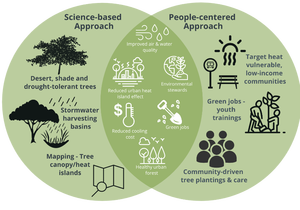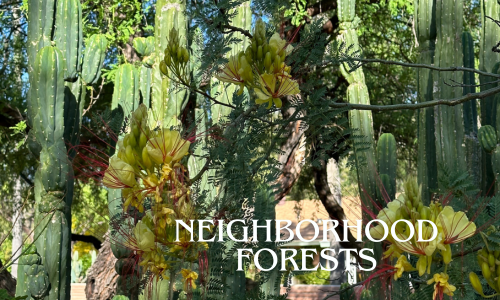A way to cool the temperature during Tucson summers
Neighbors coming together to proactively employ proven methods of combatting the summer desert heat. The cutting-edge technology they are using? Trees.
Although we are barely into April, temperatures will rise in Southern Arizona before we know it—and we will all spend the next several months attempting to cool down in a variety of ways. I recently read an article that featured a Tucson neighborhood and their living “food pantry”. Almost 30 years ago, a pair of brothers in the Dunbar Springs got neighbors together for a community-wide tree planting event with the intent of shading the streets in the barren neighborhood. These events continued and blossomed into not only tree and understory plantings (plantings that are lower to the ground and require less light), but also rainwater diversion and collection based on ancient Indian techniques, enhancement of wildlife habitats (assisting also in the encouragement of further wildlife diversity) and urban farming.
Today, the neighborhood is resplendent with 1700+ trees and thousands of other plants. The community now harvests food from many of these plantings and holds events to educate others on how to create their own neighborhood “forest”. While I love the idea of urban farming (I love a prickly pear margarita or juice as much as the next gal), what interested me even more were the statistics on how it has helped with the heat. My attention was piqued by this sentence from the article— “One day in September, the temperature on an exposed street in Dunbar Spring was 123F (50C), while a shaded street was just 85F (30C) – a 38F (20C) difference.”
Obviously, I knew that shade would make a difference—I had heard that it was around ten degrees—but a 38 degree difference?? Holy cats! That was substantial. I dug a little further and found that the lack of tree canopy was becoming such a problem in urban areas that many cities are implementing massive programs to plant more trees—and not to create a park-like ambiance. Here, we have the Tucson Million Tree program with its goal of planting a million trees in the Tucson area by 2030.

Infographic from the Tucson Million Trees program
Heat related illnesses and deaths are on the rise—and seniors and those living in neighborhoods with lower incomes are the most at-risk. Many of the lower cost neighborhoods in the Tucson area are in desperate need of trees. From Google satellite the differences are apparent and pretty shocking. It would be amazing if we were able to change this—the difference it could bring for generations to come could be literally life-saving. Check out this page about the tree equity in the Tucson area.
Neighborhood “forestification” can increase Tucson home values
$5 Trees and Lower Electric Bills (and higher home values?)
In our own Oro Valley neighborhood, there are large mature Mesquite and Palo Verde trees everywhere, as well as some towering eucalyptus and pine trees—and I will say that it feels cooler than the last neighborhood we lived in (a few miles away). The previous owners of our home planted quite a bit and we have added on to that over the years. The western and south side of our property is now almost completely canopied, which helps block the sun from the house and creates a pleasant space during the moderate times of day in the summer. (The photo at the top of the post was taken there in the spring.)
It’s been reported that trees planted in the right spots around a home can reduce air conditioning needs by 30%, adding up to a huge savings on monthly bills. Tucson Electric Power has a program that offers up to three trees for $5 each—providing you plant them in designated spots to maximize shade capabilities. Do you already have a mesquite in your yard? Keep an eye out for little saplings that start around them from seed—these can be transplanted to different locations and grow faster than you might think. Tucson Clean and Beautiful also has trees for sale at a lower cost than most nurseries.
A more attractive yard and lower electric bills not enough to entice you? How about an increase in your home value. Several surveys have indicated that mature trees can increase a homes values by 3-15%. That translates to 12-60K on a $400,000 home. Our advice as real estate agents? Barren lots are rarely desired here. If your lot is devoid of trees—get planting NOW. Most trees take five years or more to become fully established. (But be strategic and take care not to block any of those coveted mountain views if you have them! 😊)
Seek out some neighbors who might want to hop on board with you and start working toward raising the value of the whole neighborhood! (It’s a good idea to contact your HOA prior to purchasing or planting to check if they have any limitations on species or placement.)
Looking for other ways to reduce costs, beat the heat and be more Earth-friendly? Check out this blogpost for things that we do in our own home.


